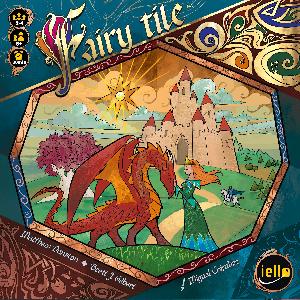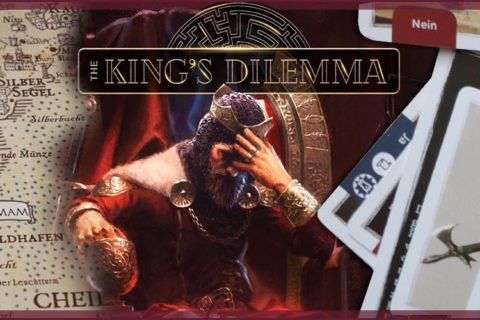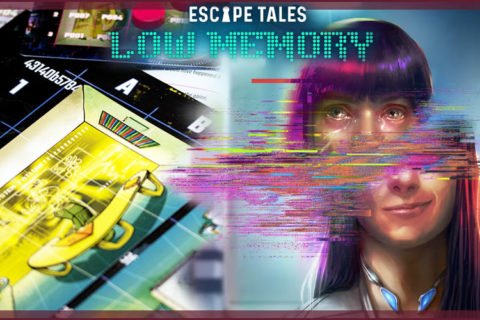Fairy Tile – Once upon a Tell as board game
 Once upon a time, there was a kingdom where all sorts of strange things happened and they all had to do with a princess, a knight and a dragon: The trap for the dragon Draxor is ready. Now, Knight Ulrich only has to wait until the beast lands at the great river. But in the next moment, Princess Flora is unexpectedly kidnapped by pirates. But never fear. Knight Ulrich will fearlessly climb the mountain to free her, after all, that’s what he promised the King. That must have been right after he married Flora. Um, hang on. There’s something wrong…
Once upon a time, there was a kingdom where all sorts of strange things happened and they all had to do with a princess, a knight and a dragon: The trap for the dragon Draxor is ready. Now, Knight Ulrich only has to wait until the beast lands at the great river. But in the next moment, Princess Flora is unexpectedly kidnapped by pirates. But never fear. Knight Ulrich will fearlessly climb the mountain to free her, after all, that’s what he promised the King. That must have been right after he married Flora. Um, hang on. There’s something wrong…
Fairy Tile will take you to fairyland. In the legend game by the authors Matthew Dunstan and Brett J. Gilbert from IELLO not with but against each other to tell a story. The first of the two to four players to finish his fairy tale book, which consists of different sections of a story in the form of tasks, wins. And they lived happily ever after. Or something like that… Of course there is more to it than just reading the text of cards. But what you will notice first is the great presentation of the game. And if there’s one thing IELLO can do, it’s make games that look pretty. Responsible for the excellent illustrations in this game is Miguel Coimbra, who among other things also breathed life into 7 Wonders and Smallworld.
In a kingdom far, far away… Storytelling made easy
As a family game from the age of 8, the rules for Fairy Tile are very clear and easy to learn. Your main task is to tell the story of the princess Flora, the knight Ulrich and the dragon Draxor. The pile of story cards is distributed equally to all players. Each player may now look at the top card of their hidden stack. In addition to a beautiful illustration, you will find a task on the cards that is part of the story of the three protagonists and which you have to complete. For example, the princess and the dragon must meet in the forest.
The kingdom in which the story takes place consists of parts, each of which consists of three hexagonal areas. These can be castles, plains, mountains or even forests. A river can also flow through these areas, which is then shown on the parts. When building the game you put three of these starting parts together. On them the starting point for the three protagonists is marked.
In order to complete your task, you can either move one of the pieces on the territories of the kingdom during your turn or create a new territory tile. No one has their own piece in Fairy Tile, but everyone plays with all the pieces. When you create a tile, you must make sure that at least two edges of the tile are touching the tile you already have. Also, rivers must not be cut off.

Which way is Dragon Mountain? – Now there’s some movement in the story
If you want to move a character, you must follow the rules for that character. The dragon always flies straight ahead to the edge of the playing field. The princess may only move one square further at a time. If you wish, she can jump from one castle to another either before or after the dragon flies. The knight, on the other hand, can run two fields further. However, he may not return to the starting field or to any of the adjacent fields. This sounds more complicated than it is and is easy to remember.
When you have done one of these two actions, you check if you have completed your task. There are three types of tasks: Visit, meet or see. So if you want the princess and the dragon to meet in the forest, they have to stand together on the same forest field. You must also have moved one of the two characters in your action. This does not apply if they were previously placed there by someone else. It is similar with the visitation tasks. You must also have moved the figure you want to visit an area during your turn. The Seeing tasks are an exception. Here, you do not necessarily have to move a figure. You can also have created a tile in your action.
Placing tiles can be very important, because sometimes a large forest (at least three contiguous forest areas) or a large river (flowing through at least five areas) is required. These tasks then belong to the more difficult ones, which usually cannot be solved with one move.
Finally, you can also discard orders and draw a new order if you give up your action for it. In return, you will receive a double move, which you can use whenever you want.
Fairy Tile: A fairytale beauty and mechanically tricky
There’s one thing that can’t be disputed: Fairy Tile is equipped with such beautiful and high quality components and has such pretty illustrations like no other game. Already with the first announcement of IELLO about the game, I fell in love with the optics immediately. Each of the 36 cards of the fairy tale book has its own illustration matching the story. And after the terrain parts have been scratched out, you don’t even want to throw away the punched frames, because even those look beautiful then. But the optics alone do not make a game a good game. So how does Fairy Tile play?
Deductions in B grade
The answer is: mixed. We certainly had our fun with it. It has its problems, though. First of all, the tasks are very different in their level of difficulty and who has to do which task is simply a matter of chance. Thus, the vision tasks are easier to complete at the beginning of the game when the kingdom is not yet that large. Dragon tasks also become increasingly difficult as the kingdom expands. Due to its movement type, which only stops at the edge of the game area, it becomes more and more difficult to target specific areas.

Two is one too few
In our experience, Fairy Tile works best with 4 players. The fewer players there are, the worse the mechanics work. With two players it is very common that both have to move the same piece, but in opposite directions. So one moves the piece from A to B and the other from B to A. This is repeated, because neither of them wants to give way. We have found that in a two-player game, the winner is usually the one who has been able to prevail.
Now, the purpose of the double move is to compensate players for unfavorably drawn tasks and to offer them a chance to swap. However, the previous task is then gone for the time being. They are pushed under the stack and only come out again at the end of the game. However, there is no guarantee that the next task will be easier to solve. A double move, however, can solve such stalemate situations where you only move back and forth. But if you need more than two moves to move one of the pieces to the required place, it becomes difficult. And that’s not so unlikely towards the end of a game with a large playing area. You might need five or more moves to get the dragon somewhere. If the dragon is moved somewhere else by another player in between, you can often start all over again with the well thought out flight path. These are the moments that are frustrating in Fairy Tile.

Strange situations and the right age
But of course not everything is bad. The call character is very big because of the cute figures. Not only our children had fun with Fairy Tile. Also among the adult players some of them couldn’t get enough. Although the story of the cards is not told in the right order during the game, but that’s exactly what provided fun moments again and again. Here we tried to tell a story around the parts of the actual story. Sometimes this works quite well, sometimes not. However, Fairy Tile is not a real storytelling game. For that the parts taken out of context are too confused.
The age rating from 8 years on puts the game into the series of family games. However, children should already be able to read well enough to decipher the somewhat squiggly writing. The bold keywords in the tasks will definitely help here. The game components have a great appeal for smaller children and our 5-year-old daughter also liked to play with the figures and plan parts in this way. In our experience, however, it quickly loses its appeal for somewhat older children. However, all children were very happy about the story, which can be told with the cards in the right order. This had to be after a game in any case. As a last game of the day or a simple game for in between with family or friends Fairy Tile is suitable in any case. And so it will also get a permanent place in our game collection and from time to time with the right group it will be on the gaming table. But we will prefer to do without the two of us.





Leave a Reply